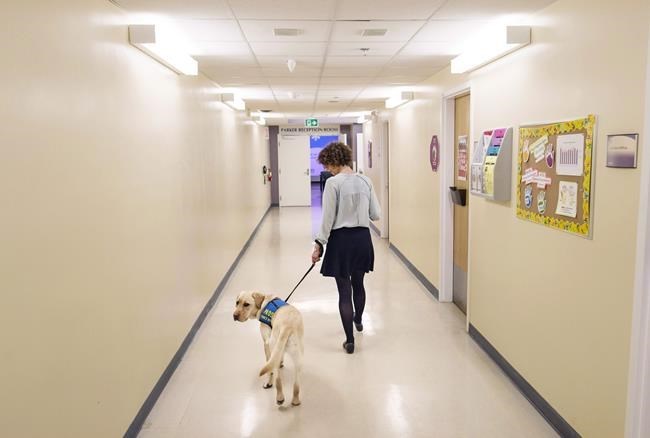
Dorado, the first accredited facility dog in Atlantic Canada, walks down a hallway in the IWK hospital with his handler Kathy Bourgeois in Halifax on Friday, December 8, 2017. Therapy dogs may help reduce pain and improve well-being for emergency room patients, a new study from researchers at the University of Saskatchewan suggests, but authors say further analysis is needed to determine why and how the animals seem to help. THE CANADIAN PRESS/Darren Calabrese
March 09, 2022 - 11:06 AM
Therapy dogs may help reduce pain and improve well-being for emergency room patients, a new study from researchers at the University of Saskatchewan suggests, but authors say further analysis is needed to determine why and how the animals seem to help.
The study, conducted in 2019 with nearly 200 emergency department patients at Saskatoon's Royal University Hospital, found that participants reported "clinically significant" changes in pain, anxiety, depression and well-being following a 10-minute visit from a therapy dog and its handler, compared to those who received standard treatment without a dog visit.
Nearly half of the patients who received visits from the St. John Ambulance dogs reported a reduction in anxiety – 48 per cent – while 46 per cent said they were less depressed after meeting the animals and their handlers. Forty-three per cent reported a decrease in pain and 41 per cent said they felt an improvement in their overall well-being.
The results were published Wednesday in the peer-reviewed journal PLOS ONE.
Colleen Dell, co-author of the study and a sociology expert at the University of Saskatchewan, said the findings echo previous research suggesting benefits of therapy dogs within other settings.
Dell said the study is the first, to her knowledge, that looked at the role of therapy dogs in potentially decreasing pain among emergency department patients, adding it provides a jumping off point to understand why some people might benefit from canine visits in a stressful, emergency environment.
"Patients had clinically significant changes – a reduction in their pain, their depression, their anxiety, and an increase in their well-being – and (seeing) that using a controlled clinical trial method, that's really strong evidence," Dell said. "We're excited to release these really solid findings and hopefully do more studies on this to understand more of the why.
"I really see this as a pivotal point.... We know (dogs) have a pain-relieving effect. But how does that happen?"
Dell said that won't be an easy question to answer, noting that pain, including emotional and sensory pain, is "unique to the individual" and context-dependent.
She said anxiety tends to increase pain levels, so being in chaotic environments like emergency departments could elevate pain for some. If dogs can be brought in to reduce that anxiety, can that decrease pain for some patients, Dell asked?
"It might be that the dogs are helping distract the individual; it may be the person's perception of their pain (that changes)," she said.
"But there's also biological markers like cortisol – you have these feel-good, happy moments when you're petting the dog – so something could be happening there as well."
The study measured pain, anxiety, depression and well-being with an 11-point rating scale at different intervals.
The 97 participants in the dog therapy group were assessed by researchers three times – before the dog's visit, immediately afterwards and again 20 minutes later – while the 101-particpant control group was interviewed twice at a 30-minute interval.
Blood pressure and heart rate were measured in both groups, though the study found those metrics weren't impacted by the visiting dog teams.
Limitations of the study included recruiting participants from only one hospital site and not asking them about medications taken at home that may have influenced pain scores. Medications given to patients in hospital were factored into the findings, however.
The authors note that "future studies should improve upon our research design." Dell said the goal is to expand the research in ways that could offer a more complete picture.
She said it's feasible to make therapy dogs and their handlers part of normal care teams in hospitals, noting that strict measures for infection control and prevention would need to be maintained.
She added that being transparent about the dogs' presence with proper signage is also important to not raise anxiety in patients who may be afraid or dislike the animals.
"You want to be really careful about that ... (but) these are really calm dogs," Dell said. "If you were reading a book or you weren't really paying attention, you wouldn't have even known they walked by."
This report by The Canadian Press was first published March 9, 2022.
News from © The Canadian Press, 2022